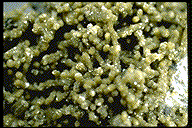 |
The Borates Subclass A Subclass of the Carbonate Class of Minerals
|
The Borate minerals are more complex in their structures than typical carbonates, but because of the scarcity and limited distribution of boron in the Earth's crust there are only a few borates that can be considered common.
Because boron in the BO3 ionic group has a positive three (+3) charge, it only requires half of the bond strength of each negative two (-2) oxygen. This allows the oxygens to bond with other borons evenly and thus link boron groups together into compound groups, chains, sheets and even a framework structure using BO4 tetrahedrons linked to BO3 groups. This makes the borates similar to the many structural variations found in the Silicate Class of minerals. These structural variations explain the large size of this subclass in terms of numbers of species. The chemistry is certainly not the culprit. There is little variation in the chemistry of these minerals as a quick scan of the list below reveals mostly sodium, calcium and/or magnesium borates, many with hydroxides, many hydrated and some with chlorine; but little else in terms of chemical variation.
The Borates Subclass:
Admontite (Hydrated Magnesium Borate)Aksaite (Hydrated Magnesium Borate Hydroxide)Ameghinite (Sodium Borate Hydroxide)Ammonioborite (Hydrated Ammonia Borate)Aristarainite (Hydrated Sodium Magnesium Borate)Bandylite (Copper Hydroborate Chloride)Behierite (Tantalum Niobium Borate)Berborite (Hydrated Beryllium Borate Hydroxide Fluoride)Biringuccite (Hydrated Sodium Borate Hydroxide)Blatterite (Manganese Magnesium Antimony Iron Borate Oxide)- Boracite (Magnesium Borate Chloride)
- Borax (Hydrated Sodium Borate)
Braitschite (Hydrated Calcium Sodium Cerium Lanthanum Borate)Calciborite (Calcium Borate)Chambersite (Manganese Borate Chloride)Chelkarite (Hydrated Calcium Magnesium Borate Chloride)Clinokurchatovite (Calcium Magnesium Iron Manganese Borate)- Colemanite (Hydrated Calcium Borate Hydroxide]
Congolite (Iron Magnesium Manganese Borate Chloride)Diomignite (Lithium Borate)Ekaterinite (Hydrated Calcium Borate Chloride Hydroxide)Ericaite (Iron Magnesium Manganese Borate Chloride)Ezcurrite (Hydrated Sodium Borate)Fabianite (Calcium Borate Hydroxide)Federovskite (Calcium Magnesium Manganese Borate Hydroxide)Fluoborite (Magnesium Borate Fluoride Hydroxide)Frolovite (Calcium Hydroborate)Ginorite (Hydrated Calcium Borate)Gowerite (Hydrated Calcium Borate)Halurgite (Hydrated Magnesium Borate Hydroxide)Hambergite (Beryllium Borate Hydroxide)Henmilite (Calcium Copper Hydroborate Hydroxide)Hexahydroborite (Hydrated Calcium Hydroborate)Hilgardite (Hydrated Calcium Borate Chloride)Howlite (Calcium Borate Silicate Hydroxide)Hulsite (Iron Magnesium Antimony Borate)Hungchaoite (Hydrated Magnesium Borate Hydroxide)- Hydroboracite (Hydrated Calcium Magnesium Borate Hydroxide)
Hydrochlorborite (Hydrated Calcium Borate Chloride Hydroxide)Inderborite (Hydrated Calcium Magnesium Borate Hydroxide)Inderite (Hydrated Magnesium Borate Hydroxide)Inyoite (Hydrated Calcium Borate Hydroxide)Jeremejevite (Aluminum Borate Fluoride Hydroxide)Jimboite (Manganese Borate)Johachidolite (Calcium Aluminum Borate)Kaliborite (Hydrated Potassium Magnesium Borate Hydroxide)Karlite (Magnesium Aluminum Borate Hydroxide Chloride)- Kernite (Hydrated Sodium Borate)
Korzhinskite (Hydrated Calcium Borate)Kotoite (Magnesium Borate)Kurchatovite (Calcium Magnesium Manganese Iron Borate)Kurnakovite (Hydrated Magnesium Borate Hydroxide)- Larderellite (Ammonia Borate Hydroxide)
Ludwigite Group (Magnesium Iron Nickel Titanium Antimony Aluminum Borate)Magnesiohulsite (Magnesium Iron Antimony Borate)Mcallisterite (Hydrated Magnesium Borate Hydroxide)Meyerhofferite (Hydrated Calcium Borate Hydroxide)Nasinite (Hydrated Sodium Borate Hydroxide)Nifontovite (Hydrated Calcium Borate Hydroxide)Nobleite (Hydrated Calcium Borate Hydroxide)Nordenskioldine (Calcium Antimony Borate)Olshanskyite (Calcium Hydroborate)Orthopinakiolite (Magnesium Manganese Borate)Penobsquisite (Hydrated Calcium Iron Borate Hydroxide Chloride)Pentahydroborite (Hydrated Calcium Hydroborate)Peprossiite (Cerium Lanthanum Aluminum Borate)Pinakiolite (Magnesium Manganese Antimony Borate)Pinnoite (Hydrated Magnesium Borate)Preobrazhenskite (Magnesium Borate Hydroxide)Priceite (Calcium Borate Hydroxide)Pringleite (Hydrated Calcium Borate Hydroxide Chloride)Probertite (Hydrated Sodium Calcium Borate Hydroxide)- Rhodizite (Potassium Cesium Beryllium Aluminum Borate)
Rivadavite (Hydrated Sodium Magnesium Borate)Roweite (Calcium Manganese Borate Hydroxide)Ruitenbergite (Hydrated Calcium Borate Hydroxide Chloride)Santite (Hydrated Potassium Borate Hydroxide)Sassolite (Boric Acid)Satimolite (Hydrated Potassium Sodium Aluminum Chloride)Sborgite (Hydrated Sodium Borate Hydroxide)Shabynite (Hydrated Magnesium Borate Chloride Hydroxide)Sibirskite (Calcium Borate Hydroxide)- Sinhalite (Magnesium Aluminum Borate)
Solongoite (Calcium Borate Hydroxide Chloride)Strontioborite (Strontium Borate Hydroxide)Strontioginorite (Hydrated Strontium Calcium Borate)Studenitsite (Hydrated Sodium Calcium Borate Hydroxide)Suanite (Magnesium Borate)- Sussexite (Magnesium Borate Hydroxide)
Szaibelyite (Magnesium Borate Hydroxide)Takedaite (Calcium Borate)Takeuchiite (Magnesium Manganese Iron Borate)Teepleite (Sodium Hydroborate Chloride)Tertschite (Hydrated Calcium Borate)- Tincalconite (Hydrated Sodium Borate)
Trembathite (Magnesium Iron Borate Chloride)Tunellite (Hydrated Strontium Borate Hydroxide)Tusionite (Manganese Antimony Borate)Tuzlaite (Hydrated Sodium Calcium Borate Hydroxide)Tyretskite (Hydrated Calcium Borate Hydroxide)- Ulexite (Hydrated Sodium Calcium Borate)
Uralborite (Calcium Borate Hydroxide)Veatchite (Hydrated Strontium Borate Hydroxide)Vimsite (Calcium Borate Hydroxide)Volkovskite (Hydrated Potassium Calcium Borate Hydroborate Chloride)Wardsmithite (Hydrated Calcium Magnesium Borate)Warwickite (Magnesium Titanium Iron Aluminum Borate Oxide)Wightmanite (Hydrated Magnesium Borate Oxide Hydroxide)Yuanfuliite (Magnesium Iron Aluminum Titanium Borate Oxide)
Subclass: Iodates
Bellingerite (Hydrated Copper Iodate)Bruggenite (Hydrated Calcium Iodate)Lautarite (Calcium Iodate)Salesite (Copper Iodate Hydroxide)Schwartzembergite (Lead Iodate Oxide Chloride Hydroxide)
Subclass: Nitrates
- Buttgenbachite (Hydrated Copper Nitrate Chloride Hydroxide)
Darapskite (Hydrated Sodium Sulfate Nitrate Hydroxide)Gerhardtite (Copper Nitrate Hydroxide)Hydrombobomkulite (Hydrated Nickel Copper Aluminum Nitrate Sulfate Hydroxide)Likasite (Hydrated Copper Nitrate Hydroxide)Mbobomkulite (Hydrated Nickel Copper Aluminum Nitrate Sulfate Hydroxide)- Niter (Potasium Nitrate)
- Nitratine (Sodium Nitrate)
Nitrobarite (Barium Nitrate)Nitrocalcite (Hydrated Calcium Nitrate)Nitromagnesite (Hydrated Magnesium Nitrate)Sveite (Hydrated Potassium Aluminum Nitrate Chloride Hydroxide)








